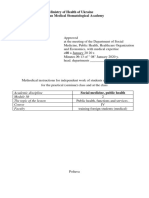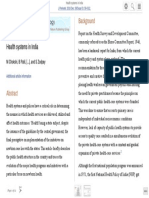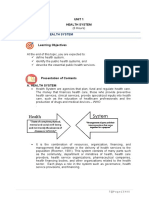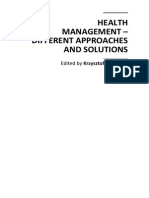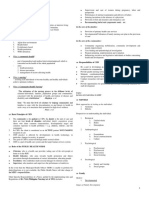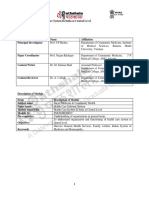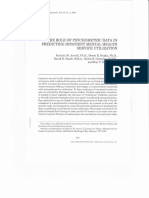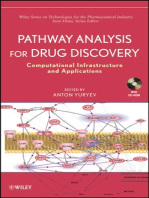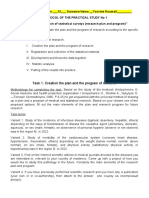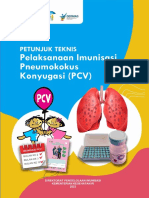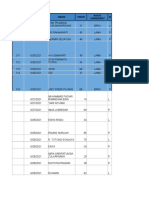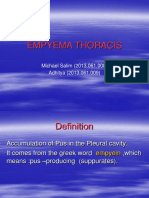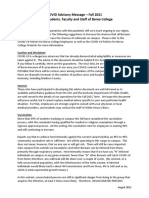O. Holyachenko, A. Shulhai, O. Nykytyuk
SOCIAL MEDICINE AND HEALTH PROTECTION ORGANIZATION
The textbook for foreign students of medical institutions of III-IV accreditation levels
Edited by:
Oleander Holyachenko, Arkadi Shulhai, Oleh Nykytyuk Reviewers:
I. Prokop —
Associate Professor of the Chair of Foreign Languages of Ternopil State Medical University by
I.Y.
Horbachevsky;
V. Mezentsev —
Associate Professor of the Chair of Social Medicine and Healts Care Organization of Kharkiv Post-Diploma Physician Academy;
R. Blonsky —
Candidate of Medical Sciences, Associate Professor of the Chair of Social Medicine and Healts Care Organization of Ivano-Frankivsk Medical Academy;
V. Kondratyuk —
DM, DM, Professor, Head of the Chair of General Hygiene and Human Ecology of Ternopil State Medical University by I.Y. Horbachevsky.
Holyachenko O., Shulhai A., Nykytyuk O.
H 75 Social medicine and health protection organization. — Ternopil: Ukrmedknyha, 2005. - 164 p. ISBN 966-673-015-4 This textbook is written according to program for the foreing students of higher medical institutions on social medicine and health protection organization. The indicated program conrains with a main circle of problems, which one compound nature of social medicine and health protection organization and its are required to the future doctors in their activity.
Contents
Abbreviation List 5 Preface 6 Section 1. Theoretical bases of social medicine and health protection organization 7 Section 2. Statistics 20 2.1 The bases definitions 20 2.2 Relative and average values and their reliability 26 2.3 Dynamic analysis 38 2.4 Graphic representation and graphic analysis 44 2.5 Standardization ...... 50 Section 3. Health of the population 56 3.1 Health bases parameters of the population 56 3.2 Social-medical aspects of major chronic diseases 71 Section 4. Organization of public health services and medical care 79 4.1 Organisation features of treating-and-prophylactic care to urban population, workers of industrial enterprises and constructions 86 4.2 Maternity care and childhood 89 4.3 Medical care to rural population 98 4.4 Organization of work of Primary care center (PCC) 100 Section 5. Sanitary-epidemiological services... (SES) 102 Section 6. Economy, planning, financing of establishments of the public health services in Ukraine 118 Section 7. The automated control systems in the establishments of public health services in Ukraine 119 Section 8. Social insurance and social security. Medical insurance in Ukraine 125 Section 9. Organization of primary health care (PHC) on the bases of family medicine 131
Section 10. The systems of public health services in the some economically developed countries (USA, the European countries) 149 Section 11. Formation of healthy way of life 155 Section 12. Activity of the societies of Red Cross and Red Crescent 159 Annotated bibliography 163
ABBREVIATION LIST
AIS Automatic information system BC Bed complement BO Bed occupancy C S Computer system D H District hospital GP General practitioner GNO Gross national output L H Local hospital MPH's Ministry of public health services ME Medical establishment MC's Medical commission of specialist MSD Medical sanitary department PCC Primary care center PHC Primary health ( medical sanitary) care PMC Primary medical care PMSC's Primary medical social commission of specialist PP Primary prevention R H Regional hospital SES Sanitary-epidemiological services SMC Secondary medical care SP Secondary prevention SPH School of public health TC Tertiary care TMC Tertiary medical care TP Tertiary prevention UNO United Nations Organization WHO World Health Organisation WAHO World Assembly of W H O
PREFACE
Social - medical aspect is one of the basic directions of activity of each doctor and medical assistant. Each medical worker should understand social conditions of a person's health and organizational actions for its improvement. For this purpose the one who studies medicine, should seize the basic method of knowledge of the social - medical phenomena - statistical, to be able to give correct interpretation of parameters of public health - mortality, morbidity, mental development, - to understand their tendencies, to connect a state of health with bases of the organization of public health services and medical care, to know the structure and functions of organizational forms of medical care. During gradual development of mankind its health has been considerably improved. Now in the world, unfortunately not everywhere, the high level of quality and length of life were achieved. And all this is due to social reforms, in particular in the organization of medical care for people. On this way new grandiose discoveries and achievements are waiting for mankind. The social medicine and the organization of public health services lays between biological and social sciences involved in exploration of the activities of normal human body and human body with pathologies. The social medicine and the organization of health care plays an important role in the formation of the physician. This textbook is written on the basis of the program of social medicine and the organization of public health services for students of medical institutes and colleges authorized by Ukrainian Department of health protection organization. The program covers the basic circle of questions, which form the essence of social medicine and are extremely necessary for the middle level of medical worker in his activity. Peculiarities of the present stage of social medicine and the organization of public health services development in Ukraine is that it should theoretically motivate reformation of the system of public health services which is being held in the state. It is extremely complicated task, and, in addition, it is far from being completed. Therefore, we have many polemic judgments, concepts and programs. In these conditions objective complexity of the creation of a modern textbook from social medicine and the organization of public health services arises. Processes relevant to the health of people and the organization of its protection are rather dynamic. Taking into account this dynamism, in the given textbook certain corrective amendments are made which, however, do not change adopted program at all. It is one more problem that authors who write about social medicine and the organization of public health services are facing. Readers will decide in what measure these complex and differences barriers were overcome.
Section 1.
THEORETICAL BASES OF SOCIAL MEDICINE AND HEALTH PROTECTION ORGANIZATION
Social medicine is a science that studies social laws of peoples health and characterizes ways of its improvement according to rational organization of public health services.
Social medicine lays between biological and social sciences which are involved in studying the essence of health and morbidity of a person. Bases features that differ social medicine from fundamental and clinical disciplines that occupy a prevailing part of teaching at the high and secondary medical schools are the following: 1. The subject of its interest are health and diseases of groups of people - collectives, populations, society as a whole, not the separate person, in other words not health or morbidity of an individual, but the public's one. 2. Considering the occurrence, pathogenesis and clinics of separate diseases all of them are equivalent between themselves. In fact it is impossible to imagine the physician who has well learnt etiology, pathogenesis and clinic of hyper tonic disease but is poorly acquainted with the same questions dealing with stomach ulcer. From positions of social medicine diseases are not equivalent, because at a certain historical stage they influence public health differently. So, 50-60 years ago most people were dying from epidemic diseases and tuberculosis, now - from so-called chronic degenerate diseases (of heart and vessels, malignant formations, chronic diseases of lungs, etc.). 3. Fundamental and clinical sciences consider health and diseases to be a biological phenomenon, social medicine - the social one. An individual is a complex biopsychosociological system. It can be viewed under three corners of sight: as a biological organism, as a personality (the carrier of consciousness) and as a carrier of social quality (Fig. 1). A person as a biological organism is characterized by the following properties: anatomy, physiology of his organs and systems, age, sex, constitution. Through heredity biological properties are transferred to descendants.




